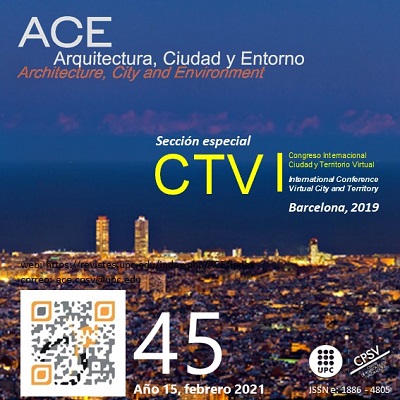Photovoltaic Capacity and Integration in Mid-rise Multifamily Buildings in the Andean Equatorial Region
DOI:
https://doi.org/10.5821/ace.15.45.9307Keywords:
multifamily building, BAPV, BIPV, solar roofAbstract
This research analyzes photovoltaic roofs in a medium-size mixed-use building, evaluating solar technologies for different levels of architectural integration, with the goal of achieving maximum energy self-sufficiency and emission reductions. The implemented methodology collects and analyzes data from temporary electric consumption readings of electric meters with a quarter-hour resolution, electricity consumption sheets, and registration of the demand for liquefied petroleum gas through surveys. The electric consumption of the building is analyzed using current occupation data and the projection of photovoltaic installations is done considering the theoretical usage of different technologies. Computer tools are used to find the adaptability and photovoltaic occupation, and to simulate the electrical production, showing the consequences of architectural integration. The findings of the study show that it is possible to incorporate 338.4 m² of monocrystalline silicon modules, reaching a production of 196.8 kWh/m2/year and potentially reducing 47.2 t of CO2 per year. It is estimated that energy self-sufficiency can reach up to 99.72% with current levels of electricity consumption. However, if the added electricity from the conversion of fuel consumption in the building to electricity is considered, extrapolated to the maximum possible user occupation and inclusion of electric chargers for vehicles, this estimate is reduced to 27.85%. This demonstrates that there is a significant potential for introducing solar energy sources in Ecuador, given the high and stable average annual insolation of the country. However, state policies and the lack of incentives and support limit the incorporation of these systems.
Downloads
Published
Issue
Section
License
| INTELECTUAL PROTECTION CRITERIA |
At this moment, it is count with the "Oficina Española de Patentes y Marcas", while global protection it is being processed by the World Intelectual Property Organization (OMPI/WIPO). Nevertheless the International Standard Serial Number Office (ISSN) has given the following numbers ISSN: 1886-4805 (electronic version) and 1887-7052 (paper version). All articles will be peer reviewed, using double blind reviewing. |
| COPYRIGHT |
The article contents and their comments are authors exclusive liability, and do not reflect necessarily the journal editor commitee's opinion. All ACE published works are subject to the following licence CC BY-NC-ND 3.0 ES http://creativecommons.org/licenses/by-nc-nd/3.0/es/ It implies that authors do not hold nor retain the copyright without restrictions but only those included in the licence. |


































